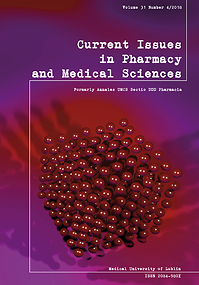Comparison of oral bioavailability of acetaminophen tablets, capsules and effervescent dosage forms in healthy volunteers
DOI:
https://doi.org/10.1515/cipms-2018-0001Keywords:
pharmacokinetics, acetaminophen, HPLC, kinetic modeling, effervescentAbstract
A wide variety of acetaminophen dosage forms have been administered to relieve mild to moderate pain and fever, so far. The purpose of this study was to compare the oral bioavailability in healthy volunteers, of three of these dosage forms. We included healthy volunteers in our study and divided replace with placed them into three groups: tablet, capsule and effervescent. Each dosage form contained 500 mg of acetaminophen as active material. Blood samples were taken at 0.5, 1, 2, 4 and 8-hour intervals after receiving the dose. Acetaminophen blood levels were measured using HPLC method. Data were fit in a “one-compartment PK model”, using P-Pharm 1.5 software and analyzed under statistical tests. The maximum concentrations of acetaminophen in blood samples were measured at 1h after taking the drug (6.61±3.19 μg/ml, 11.29±3.94 μg/ml and 15.25±2.54 μg/ml in groups receiving capsule, tablet and effervescent, respectively). Pharmacokinetic (PK) data analysis & modeling from the three groups showed that the half-life of acetaminophen was 140.72 min in the tablet group, 140.29 min in capsule and 132.08 min in effervescent. The area under the blood levels curve were 47.04, 40.62 and 53.11 μgmin/ml, in tablet, capsule, and effervescent groups, respectively. Statistically significant differences in PK parameters were recorded as the study replace with we compared effervescent with tablets and capsule dosage forms (p < 0.05). According to the results, the effervescent form creates better PK parameters compared with tablet and capsule forms, therefore, it is suggested replace with we suggested that this form should be administer in cases of pain and fever to achieve quick drug efficacy.References
1. Santovena A, et al.: Formulation design of oral pediatric Acetazolamide suspension: dose uniformity and physico-chemical stability study. Pharm. Dev. Techn. 2017;22:191. Google Scholar
2. Ubeda A, et al.: Blood pressure reduction in hypertensive patients after withdrawal of effervescent medication. Pharmacoepidemiol Drug Saf.2009;18:417. Google Scholar
3. Ferreira NN, et al.: A novel pH-responsive hydrogel-based on calcium alginate engineered by the previous formation of polyelectrolyte complexes (PECs) intended to vaginal administration. Drug Dev Ind Pharm. 2017;1. Google Scholar
4. Koen YM, et al.: Comparative Toxicity and Metabolism of N-Acyl Homologues of Acetaminophen and Its Isomer 3-Hydroxyacetanilide. Chem Res Toxicol 2016;29:1857. Google Scholar
5. Anderson BJ: Paracetamol (Acetaminophen): mechanisms of action. Paediatr Anaesth. 2008;18:915. Google Scholar
6. Preis M: Orally disintegrating films and mini-tablets-innovative dosage forms of choice for pediatric use. AAPS PharmSciTech. 2015;16:234. Google Scholar
7. Alam MT, et al.: FDA-Approved Natural Polymers for Fast Dissolving Tablets. J Pharm (Cairo). 2014;952970. Google Scholar
8. Rawlins M, et al.: Pharmacokinetics of paracetamol (acetaminophen) after intravenous and oral administration. Eur J Clin Pharm. 1977;11:283. Google Scholar
9. Srinath K, et al.: Formulation and evaluation of effervescent tablets of paracetamol. INT J Pharm Res Dev. 2011;3:76. Google Scholar
10. Blagden N, et al.: Crystal engineering of active pharmaceutical ingredients to improve solubility and dissolution rates. Adv Drug Deliv Rev 2007 Jul 30;59(7):617-30 Epub 2007 May 29. Google Scholara
11. De Silva L, et al.: Usability of mobile technology to screen for drugdrug interactions in kidney transplant patients. Am J Nephrol. 2014;40(2):97-104. doi: 101159/000364910 Epub 2014 Jul 19. Google Scholar
12. Moes AJ: Gastroretentive dosage forms. Crit Rev Ther Drug Carrier Syst. 1993;10(2):143-95 .Google Scholar
13. Wilding II, et al.: Development of a new engineering-based capsule for human drug absorption studies. Pharm Sci Technol Today. 2000;3:385. Google Scholar
14. Lopes CM, et al.: Overview on gastroretentive drug delivery systems for improving drug bioavailability. Int J Pharm. 2016;510:144. Google Scholar
15. Altman R, et al.: Advances in NSAID development: evolution of diclofenac products using pharmaceutical technology. Drugs. 2015;75:859. Google Scholar
16. Sohi H, et al.: Taste masking technologies in oral pharmaceuticals: recent developments and approaches. Drug Dev Ind Pharm. 2004;30:429. Google Scholar
Downloads
Published
Issue
Section
License
Copyright (c) 2018 Authors

This work is licensed under a Creative Commons Attribution-NonCommercial-NoDerivatives 3.0 Unported License.


